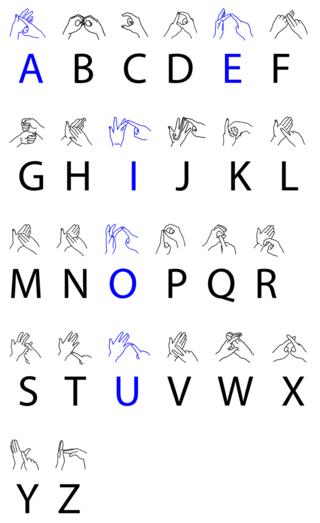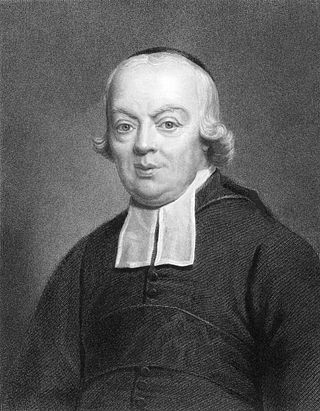
American Sign Language (ASL) is a natural language that serves as the predominant sign language of Deaf communities in the United States and most of Anglophone Canada. ASL is a complete and organized visual language that is expressed by employing both manual and nonmanual features. Besides North America, dialects of ASL and ASL-based creoles are used in many countries around the world, including much of West Africa and parts of Southeast Asia. ASL is also widely learned as a second language, serving as a lingua franca. ASL is most closely related to French Sign Language (LSF). It has been proposed that ASL is a creole language of LSF, although ASL shows features atypical of creole languages, such as agglutinative morphology.

Sign languages are languages that use the visual-manual modality to convey meaning, instead of spoken words. Sign languages are expressed through manual articulation in combination with non-manual markers. Sign languages are full-fledged natural languages with their own grammar and lexicon. Sign languages are not universal and are usually not mutually intelligible, although there are similarities among different sign languages.

British Sign Language (BSL) is a sign language used in the United Kingdom and is the first or preferred language among the deaf community in the UK. While private correspondence from William Stokoe hinted at a formal name for the language in 1960, the first usage of the term "British Sign Language" in an academic publication was likely by Aaron Cicourel. Based on the percentage of people who reported 'using British Sign Language at home' on the 2011 Scottish Census, the British Deaf Association estimates there are 151,000 BSL users in the UK, of whom 87,000 are Deaf. By contrast, in the 2011 England and Wales Census 15,000 people living in England and Wales reported themselves using BSL as their main language. People who are not deaf may also use BSL, as hearing relatives of deaf people, sign language interpreters or as a result of other contact with the British Deaf community. The language makes use of space and involves movement of the hands, body, face and head.

Deaf culture is the set of social beliefs, behaviors, art, literary traditions, history, values, and shared institutions of communities that are influenced by deafness and which use sign languages as the main means of communication. When used as a cultural label, especially within the culture, the word deaf is often written with a capital D and referred to as "big D Deaf" in speech and sign. When used as a label for the audiological condition, it is written with a lower case d. Carl G. Croneberg was among the first to discuss analogies between Deaf and hearing cultures in his appendices C and D of the 1965 Dictionary of American Sign Language.
The American Manual Alphabet (AMA) is a manual alphabet that augments the vocabulary of American Sign Language.

Louis Laurent Marie Clerc was a French teacher called "The Apostle of the Deaf in America" and was regarded as the most renowned deaf person in American deaf history. He was taught by Abbé Sicard and deaf educator Jean Massieu, at the Institution Nationale des Sourds-Muets in Paris. With Thomas Hopkins Gallaudet, he co-founded the first school for the deaf in North America, the Asylum for the Education and Instruction of the Deaf and Dumb, on April 15, 1817, in the old Bennet's City Hotel, Hartford, Connecticut. The school was subsequently renamed the American School for the Deaf and in 1821 moved to 139 Main Street, West Hartford. The school remains the oldest existing school for the deaf in North America.
Manually Coded English (MCE) is an umbrella term referring to a number of invented manual codes intended to visually represent the exact grammar and morphology of spoken English. Different codes of MCE vary in the levels of adherence to spoken English grammar, morphology, and syntax. MCE is typically used in conjunction with direct spoken English.
The history of deaf people and deaf culture make up deaf history. The Deaf culture is a culture that is centered on sign language and relationships among one another. Unlike other cultures the Deaf culture is not associated with any native land as it is a global culture. While deafness is often included within the umbrella of disability, many view the Deaf community as a language minority. Throughout the years many accomplishments have been achieved by deaf people. To name the most famous, Helen Keller and Douglas Tilden were both deaf and contributed great works to culture.

Jane Fernandes is an American educator and social justice advocate. As of August 2021, Fernandes is the President of Antioch College in Yellow Springs, Ohio. She previously served as president of Guilford College from 2014 to 2021.
Deafhood is a term coined by Paddy Ladd in his book Understanding Deaf Culture: In Search of Deafhood. While the precise meaning of the word remains deliberately vague—Ladd himself calls Deafhood a "process" rather than something finite and clear—it attempts to convey an affirmative and positive acceptance of being deaf.
In the United States, deaf culture was born in Connecticut in 1817 at the American School for the Deaf, when a deaf teacher from France, Laurent Clerc, was recruited by Thomas Gallaudet to help found the new institution. Under the guidance and instruction of Clerc in language and ways of living, deaf American students began to evolve their own strategies for communication and for living, which became the kernel for the development of American Deaf culture.
American Sign Language (ASL) is the main language of members of the deaf community in the United States. One component of their language is the use of idioms. The validity of these idioms have often been questioned or confused with metaphorical language. The term idiom can be defined as, "A speech form or an expression of a given language that is peculiar to itself grammatically or cannot be understood from the individual meanings of its elements". The following examples are written in ASL glossing. These idioms further validate ASL as a language unique and independent of English. Idioms in ASL bond people in the Deaf community because they are expressions that only in-group members can understand.
American Sign Language literature is one of the most important shared cultural experiences in the American deaf community. Literary genres initially developed in residential Deaf institutes, such as American School for the Deaf in Hartford, Connecticut, which is where American Sign Language developed as a language in the early 19th century. There are many genres of ASL literature, such as narratives of personal experience, poetry, cinematographic stories, folktales, translated works, original fiction and stories with handshape constraints. Authors of ASL literature use their body as the text of their work, which is visually read and comprehended by their audience viewers. In the early development of ASL literary genres, the works were generally not analyzed as written texts are, but the increased dissemination of ASL literature on video has led to greater analysis of these genres.

Charles-Michel de l'Épée was an 18th-century French philanthropic educator who has become known as the "Father of the Deaf". He founded Institut National de Jeunes Sourds de Paris, the first public school for the deaf, in 1760.
The first school for the deaf was established in France during the 18th century, in 1771 by Charles-Michel de l'Épée. L'Épée was the leader in establishing sign language for the deaf and is notable as the "father" of deaf education. He founded the Institut National de Jeunes Sourds de Paris. French Sign Language was developed and heavily influenced by L'Épée working with deaf people who were already using their own home signs and combining those signs with new signs, which, in this time period, became known as L'Épée sign language. This French sign language became a major foundation and influence on all international sign languages, especially on American Sign Language, which still retains much of the historical signs and signing grammatical structure that originated from France. The Cobbs School was founded in 1815 in Chesterfield County, Virginia. It was the first school for teaching Deaf and Mute people in the United States; however, it closed in 1816. The American School for the Deaf, in West Hartford, Connecticut, was the first school for the deaf established in the United States, in 1817, by Thomas Gallaudet, in collaboration with a deaf teacher, also from France, named Laurent Clerc with support from the well-known Hartford Cogswell family. Alice Cogswell was the very first student to attend this school in 1817. Thomas Gallaudet spent time in Paris observing French Sign Language and education at The National Institute for the Deaf.
si5s is a writing system for American Sign Language that resembles a handwritten form of SignWriting. It was devised in 2003 in New York City by Robert Arnold, with an unnamed collaborator. In July 2010 at the Deaf Nation World Expo in Las Vegas, Nevada, it was presented and formally announced to the public. Soon after its release, si5s development split into two branches: the "official" si5s track monitored by Arnold and a new set of partners at ASLized, and the "open source" ASLwrite. In 2015, Arnold had a falling-out with his ASLized partners, took down the si5s.org website, and made his Twitter account private. ASLized has since removed any mention of si5s from their website.
The history of deaf education in the United States began in the early 1800s when the Cobbs School of Virginia, an oral school, was established by William Bolling and John Braidwood, and the Connecticut Asylum for the Deaf and Dumb, a manual school, was established by Thomas Hopkins Gallaudet and Laurent Clerc. When the Cobbs School closed in 1816, the manual method, which used American Sign Language, became commonplace in deaf schools for most of the remainder of the century. In the late 1800s, schools began to use the oral method, which only allowed the use of speech, as opposed to the manual method previously in place. Students caught using sign language in oral programs were often punished. The oral method was used for many years until sign language instruction gradually began to come back into deaf education.

Black American Sign Language (BASL) or Black Sign Variation (BSV) is a dialect of American Sign Language (ASL) used most commonly by deaf African Americans in the United States. The divergence from ASL was influenced largely by the segregation of schools in the American South. Like other schools at the time, schools for the deaf were segregated based upon race, creating two language communities among deaf signers: black deaf signers at black schools and white deaf signers at white schools. As of the mid 2010s, BASL is still used by signers in the South despite public schools having been legally desegregated since 1954.
The establishment of schools and institutions specializing in deaf education has a history spanning back across multiple centuries. They utilized a variety of instructional approaches and philosophies. The manner in which the language barrier is handled between the hearing and the deaf remains a topic of great controversy. Many of the early establishments of formalized education for the deaf are currently acknowledged for the influence they've contributed to the development and standards of deaf education today.
Gilbert Eastman was an American educator, actor, playwright, author, and television host. He acted in American Sign Language (ASL) plays and wrote many of them. Eastman taught and performed at the National Theatre of the Deaf (NTD), while writing and performing in many of their plays. In 1993, he won an Emmy Award for co-hosting the show Deaf Mosaic.








